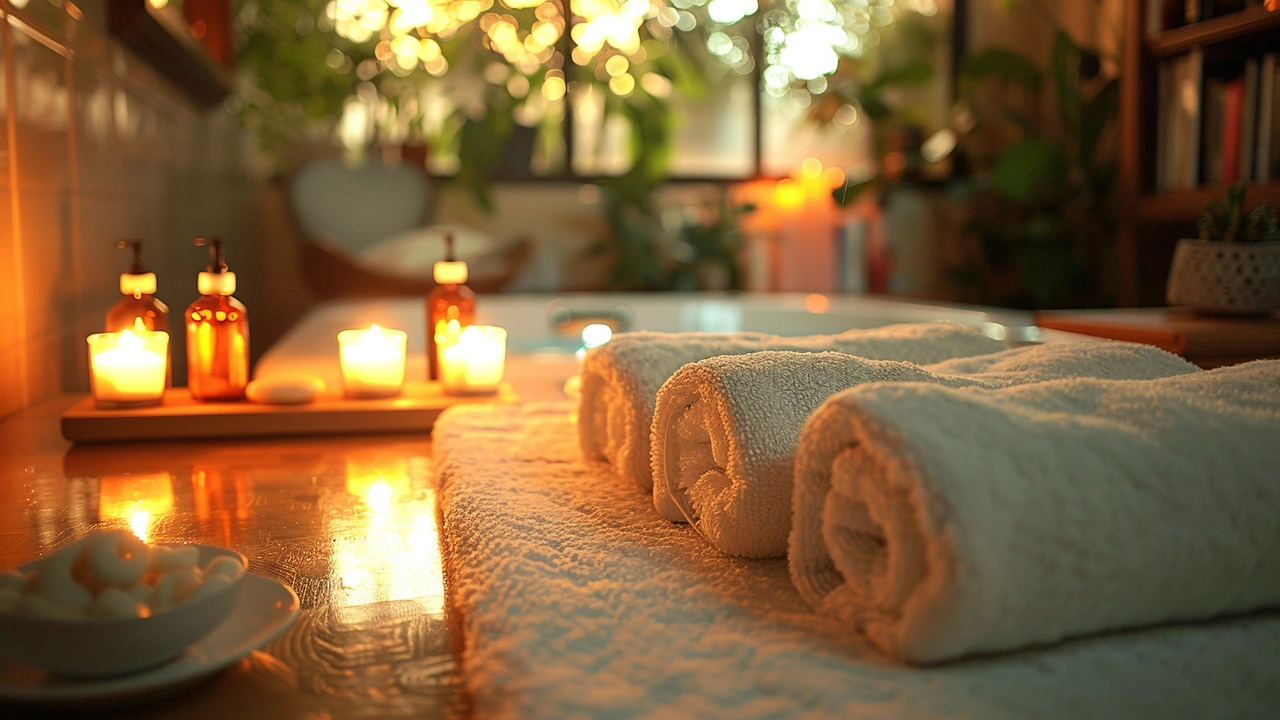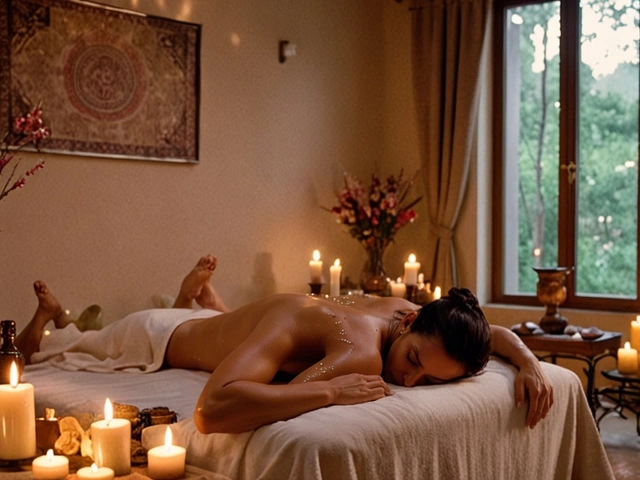When it comes to erotic massages, the choice of oil can make a world of difference. Selecting the right natural oils doesn't just enhance the physical pleasure but also deepens the emotional connection between partners.
Different oils come with their own unique properties and benefits. Understanding these can help you tailor your massage experience to suit your needs perfectly.
- Introduction to Erotic Massage Oils
- Top Natural Oils and Their Benefits
- How to Choose the Right Oil
- Safety Tips for Using Oils
- Enhancing the Experience with Techniques
Introduction to Erotic Massage Oils
The art of erotic massage is a sensual experience that intertwines physical touch with emotional connection. The oils used in these massages play a crucial role, not just in reducing friction but also in enhancing the sensory experience. When choosing an oil, it's important to consider its texture, scent, and how it complements your skin type.
Natural oils are often preferred over synthetic ones for their purity and therapeutic properties. They are less likely to irritate the skin and can offer added benefits like moisturizing and nourishing the skin. Among the popular choices are coconut oil, almond oil, jojoba oil, and grape seed oil. Each of these oils comes with its own set of advantages, making the massage not only relaxing but also beneficial for your skin.
"Using natural oils can significantly enhance the intimacy of an erotic massage. They provide a soothing sensation and help create a deeper connection between partners." - Jessica Riley, Certified Massage Therapist
For instance, coconut oil is lauded for its long-lasting lubrication and delightful scent. It is packed with antioxidants and has antibacterial properties, making it a great option for skin health. On the other hand, almond oil is known for its light texture and quick absorption, which makes it suitable for all skin types, including sensitive skin.
Another excellent choice is jojoba oil. Although technically a wax, jojoba oil's consistency is similar to the natural oils produced by our skin. This makes it especially effective in balancing oil levels and providing deep hydration. Similarly, grape seed oil is lightweight and leaves no greasy residue, making it perfect for those who appreciate a smooth, non-sticky experience.
When preparing for an erotic massage, it's essential to have a few different oils on hand to cater to various preferences and moods. Scented oils can add an extra layer of stimulation, but it's vital to choose fragrances that are subtle and not overpowering. Essential oils like lavender, ylang-ylang, and sandalwood are often blended with carrier oils to create an enticing aroma that enhances relaxation and arousal.
The choice of oil can also depend on the type of massage you intend to perform. For example, if you're looking to create warmth and enhance circulation, warming oils like ginger or cinnamon can be an exciting addition. However, it's always important to conduct a patch test to ensure there are no allergic reactions, especially when using oils with strong properties.
Top Natural Oils and Their Benefits
Choosing the right natural oil for an erotic massage can elevate the entire experience, creating a perfect blend of physical relaxation and emotional intimacy. Different oils offer unique properties and sensory delights, making the massage more exciting and deeply satisfying. In this section, we'll explore some of the best natural oils you can use and the benefits they bring to the table.
Coconut Oil: Known for its rich texture and pleasant aroma, coconut oil is a favorite for erotic massages. Its high content of fatty acids makes it incredibly moisturizing, leaving the skin feeling soft and supple. Plus, its natural scent can be quite intoxicating, adding an extra layer of sensual pleasure. Coconut oil is also anti-fungal and anti-bacterial, ensuring that your skin stays healthy. It's particularly advantageous for those with sensitive skin, as it helps to soothe and reduce irritation.
Almond Oil: Almond oil is another excellent choice for erotic massages. It's light, non-greasy, and easily absorbs into the skin, making it perfect for long massage sessions. Rich in vitamin E, almond oil helps to nourish and protect the skin, promoting a healthy glow. The oil's natural warmth and subtle, sweet scent can also help to relax the muscles and enhance the overall experience. The use of almond oil can be traced back to ancient Ayurvedic practices, emphasizing its long-standing reputation for promoting well-being and relaxation.
According to dermatologist Dr. Ava Shamban, "Almond oil is not only perfect for hydration but also has properties that can help reduce the appearance of scars and stretch marks, making it a dual-purpose choice for massages."
Jojoba Oil: Although jojoba oil is technically a wax, it mimics the skin's natural sebum, making it a fantastic option for massages. It's hypoallergenic, which means it's suitable for all skin types, including those prone to acne or other skin conditions. Jojoba oil is easily absorbed and provides a silky smooth glide, reducing the risk of friction during the massage. Additionally, it’s packed with essential vitamins and minerals, like vitamin E, B-complex, and zinc, which are beneficial for skin health.
Olive Oil: Olive oil is traditionally known for its numerous health benefits, but it is also a great massage oil. It's thick, rich, and offers a deep moisturizing effect, making it perfect for dry skin. Olive oil is laden with antioxidants that help to repair and rejuvenate the skin. Its slightly heavier texture means that it provides more resistance during the massage, which can be particularly beneficial for deep tissue work. Its natural, earthy scent harks back to the Mediterranean, adding an exotic touch to your massage sessions.
Grapeseed Oil: Light and almost odorless, grapeseed oil is a popular choice for those who prefer a non-greasy feel. Rich in linoleic acid, an omega-6 fatty acid, grapeseed oil helps to keep the skin soft and elastic. It’s also known for its anti-inflammatory properties, making it ideal for soothing sore muscles and joints. Grapeseed oil is often used in professional massage therapy due to its smooth texture and quick absorption rate. This oil is especially good for people with oily skin as it doesn't clog pores or leave a heavy residue.
Essential Oils: While not used solely as massage oils, essential oils like lavender, ylang-ylang, and sandalwood can be mixed with carrier oils to enhance the overall sensory experience. These oils offer aromatherapy benefits and can contribute to relaxation, reduced stress, and increased arousal. For instance, lavender oil is well-known for its calming properties, while ylang-ylang is thought to have aphrodisiac effects. It’s important to dilute essential oils properly before using them on the skin to avoid irritation.
How to Choose the Right Oil
Choosing the right natural oil for an erotic massage can significantly enhance the experience, adding both physical pleasure and emotional depth. The type of oil you select should cater to your unique preferences and needs. Here are some factors to consider when selecting the best oil for your massage needs.
Firstly, consider the scent. Our sense of smell is deeply tied to memory and emotion, and the right aroma can set a mood. Essential oils like lavender promote relaxation, while ylang-ylang can add an aphrodisiac element. For those who prefer something more neutral, jojoba or sweet almond oils have a very mild scent.
Next, think about the texture. Some oils are thicker and more viscous, providing a more substantial feel during the massage. Coconut oil, for instance, is thicker and melts upon contact with skin, making it an excellent option for a slow, intimate massage. Conversely, grapeseed oil is lighter and more slippery, perfect for a lighter touch and longer strokes.
"The right massage oil can transform a routine massage into an unforgettable sensory experience," says Dr. Emily Weiss, a renowned aromatherapist.
Another factor to consider is absorption rate. Oils like jojoba and sweet almond oil are easily absorbed by the skin, providing moisturizing benefits without feeling too greasy. On the other hand, olive oil takes longer to absorb, making it suitable for extended massage sessions.
Allergy potential is also a significant consideration. Before choosing an oil, ensure that neither you nor your partner has any allergies to the chosen product to avoid adverse reactions. Conducting a patch test by applying a small amount of the oil to a discreet part of the skin can be helpful.
If you prefer a more luxurious experience, you might opt for specialized blends. Many companies offer pre-mixed massage oils that combine different essential oils to target specific needs, such as relaxation or invigoration. Check the ingredient list to ensure the blend doesn't contain synthetic additives.
For those concerned with sustainability, look for organic and ethically sourced oils. Organic oils are free from harmful pesticides and chemicals, and ethically sourced products ensure that the farming practices don't harm the environment or the communities involved in their production.
Lastly, consider the bottle. Oils stored in dark glass bottles maintain their properties longer as they are protected from light and air, which can degrade the quality over time. If you use the oil frequently, think about the ease of dispensing—some bottles come with pumps or droppers that make application more convenient.
In summary, selecting the right oil involves considering the scent, texture, absorption rate, potential allergens, as well as ethical and storage considerations. By paying attention to these factors, you can ensure a soothing, sensual, and safe experience for both you and your partner.
Safety Tips for Using Oils
Using natural oils in erotic massages can be a delightful experience, but it’s important to consider safety. The first tip is to always perform a patch test before fully applying any new oil. Place a small amount on your wrist or elbow and wait 24 hours to ensure there’s no allergic reaction. This step can help you avoid unpleasant surprises that might ruin an intimate moment.
Some oils can be irritating to the skin or toxic when ingested. Be aware of which oils are safe for use on the body and which are not. For example, avoid using essential oils like wintergreen or cinnamon bark, as they can be too harsh. Stick to gentler oils such as sweet almond or jojoba, which are generally well-tolerated by most skin types.
Another crucial tip is to ensure the oil is suitable for the particular type of massage. Oils that are safe for topical application may not be suitable for internal use. For instance, coconut oil is a popular choice for massages, but it’s not compatible with latex condoms as it can cause them to break down, leading to safety concerns during intimate moments.
Maintaining proper hygiene is essential too. Ensure that your hands and any utensils you use to apply the oils are clean. This prevents the introduction of bacteria or other contaminants. Also, store your oils in a cool, dark place to maintain their integrity and avoid contamination.
Furthermore, some individuals may have sensitivities or allergies to certain oils, even natural ones. Communicating openly with your partner about any known allergies or sensitivities is important. This transparency can prevent uncomfortable or potentially dangerous situations.
According to Dr. Nina Naidu, a prominent dermatologist, “Even natural oils can cause reactions in some individuals. Always test a small amount first, ensure it’s suitable for your skin type, and consult with a professional if you’re unsure about any specific oil.”
Finally, it’s important to understand that not all oils offer the same benefits. While some oils like lavender and sandalwood can promote relaxation and reduce stress, others like peppermint can be invigorating. Knowing the properties of the oils you choose can help enhance the massage experience by matching the desired effect.
By following these safety tips, you can enjoy the myriad benefits natural oils offer without compromising your health or well-being. This allows you to focus on connecting with your partner and fully enjoying the intimate experience that erotic massages can provide.
Enhancing the Experience with Techniques
If you wish to take your erotic massage to the next level, incorporating some well-tried techniques can significantly enhance the experience. The way you use the oils, combined with certain massage methods, can turn a simple massage into a deeply intimate and memorable activity. It's not just about rubbing oil onto the skin; it's about creating a cohesive experience that engages all the senses.
Sensual Touch: Begin with slow, gentle strokes. Allow your hands to glide over your partner's skin smoothly. Using natural oils like coconut or jojoba can offer the right amount of lubrication. Pay attention to their reactions and adjust the pressure accordingly. Variations in touch, such as alternating between firm and light pressure, can surprise and delight the senses.
Amazing Aromas: Incorporating essential oils can heighten the sensory experience. Oils like lavender, ylang-ylang, and sandalwood are popular for their aphrodisiac properties. Mixing a few drops of essential oil into a carrier oil can provide both physical and emotional benefits. Don't forget to communicate with your partner to ensure the scents are pleasing to them.
“The essential joy of erotic massage lies in its ability to deepen intimate connections,” says Dr. Laura Berman, a renowned relationship therapist.
Setting the Mood: The environment plays a crucial role in the massage experience. Dim the lights, heat the room to a comfortable temperature, and play soft, soothing music. Some individuals find that placing a warm towel over specific areas before massaging them can make the experience more pleasant.
Exploring Erogenous Zones: Focus on areas that are known to be erogenous zones. The inner thighs, lower back, neck, and earlobes are just some places to start. Use gentle, circular motions and listen to your partner's cues to find what they enjoy the most. It's about creating a full-body experience that is both relaxing and arousing.
Use of Props: Integrating props like feather ticklers or silk scarves can add an extra layer of sensuality. These tools can be used to lightly brush against the skin, amplifying the sensation of the massage. The various textures can enhance the overall sensory experience.
Communication is Key: Always maintain open communication with your partner. Asking them what feels good or if they prefer something different can make a significant difference. Sometimes, just a simple question, “Do you like this?” can guide you to improve your technique.
Aftercare: Post-massage care is often overlooked but is just as important. Offer a warm shower or bath together to wash off the oils. Some prefer to leave the oils on the skin to absorb overnight. A gentle, loving embrace afterward can serve as the perfect ending to an intimate experience.
| Oil Type | Benefits |
|---|---|
| Coconut Oil | Moisturizing, Easily Absorbed |
| Jojoba Oil | Antimicrobial Properties, Long Shelf Life |
| Lavender Essential Oil | Calming, Stress-Reducing |
| Ylang-Ylang Essential Oil | Aphrodisiac, Uplifting |






